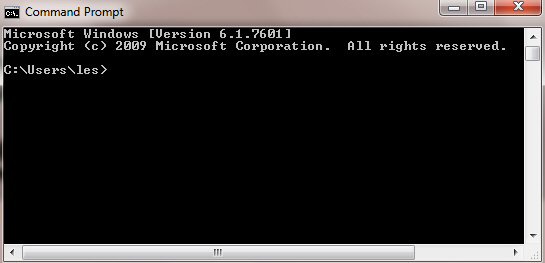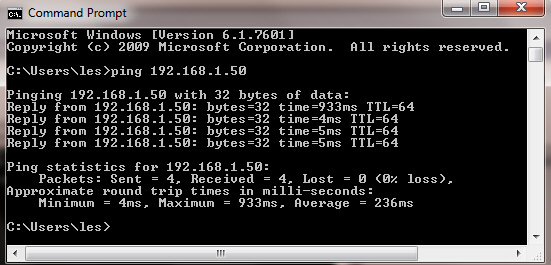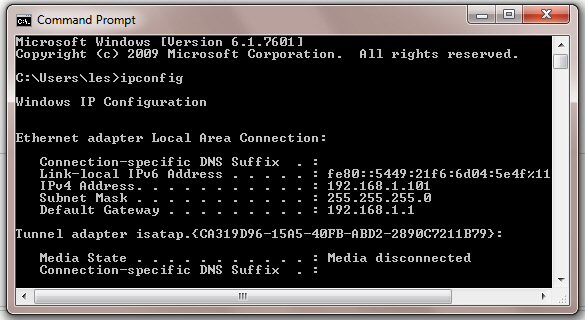
By using a DOS window you can use a couple of very useful commands to help you with setting up your IP Webcams. A ping test determines if an IP camera or other IP device can be reached on your network, and also shows the latency (communication delay) between your computer and these devices. An ARP lookup will return all your connected devices IP and MAC addresses and IPCONFIG will return a computer's IP information.
Open A Dos Window
Open a command prompt window or "DOS" window on your computer.
On modern OS (Windows 11 for example) just type cmd in the search bar and then click the resulting icon, or hold down the Windows key and r to open a window and type CMD in there.
On much older operating systems this is found in the Accessories folder or the program tree when you click the Start button. You can also just type CMD from the search bar. This will open a window similar to the one shown here.
You enter DOS commands here followed by pressing the enter button. The results are displayed in the same window.

Correct Response From A Ping
Here we entered the following command immediately after the propmpt arrow> and followed by pressing enter.
ping 192.168.1.50
The resulting display shows that the command was successfull and the IP address that we pinged was reachable and returned the response times from the device as shown. This tells us that the device is online at this address.

Error Messages Returned From A Ping Command
There are four basic types of error:- Network Unreachable - Host Unreachable, Protocol Unreachable, Port Unreachable.
Network Unreachable meassages mean that there is no route to the target network (subnet) specified and usually comes from the router. Host Unreachable usually indicates delivery failure to the target device, usually a wrong address for the device (Destination Host Unreachable). Protocol Unreachable usually means that the destination does not support the protocol in the TCP/IP packet (rarely seen). Port Unreachable messages imply that the TCP socket or port on the destination device is not available.
Most commonly you will see the message "request timed out" This implies a valid but not necessarily correct configuration at the PC end, but the target device has not responded in the time allowed, so check the configuration of the device, DVR, IP Camera etc.
The most common reasons for a timeout are:- Your device is not switched on, your device has a configuration error, The device is not plugged in, the router is down or off, network response is too slow and exceeded the default response time of 1 second.
As most problems are as a result of a configuration error somewhere, it is fairly safe to recommend "thoroughly check and double check" the settings in every IP camera, DVR, PC and Router in the chain as its easy for an error to creep in. Just one dot in the wrong place in an IP configuration will cause an error.
Response From An IPCONFIG Command
Here in our DOS window, again straight after the command prompt> we type in ipconfig and press return.
This then returns all the information about the IP configuration of the PC. This is great as providing this PC is working on the network and has access to the Internet, we have a lot of information needed for the settings for your IP camera.
The IP address is the one for this PC so your camera will be set to a different one. But the camera will need the same subnet mask and default gateway settings as returned with the IPCONFIG command - providing its to be connected to the same router as the PC.

How to determine an IP camera MAC address
Here in our DOS window, again straight after the command prompt> we type in arp -a and press return.
This will return a table showing all the connected IP cameras and other IP devices with their IP address, MAC (physical) address and whether they are a static or dynamic address.
Some routers require a devices MAC address when setting up port forwarding or DMZ so this command is really useful. Providing you know your cameras IP address you can readily see its MAC address from within the table.

